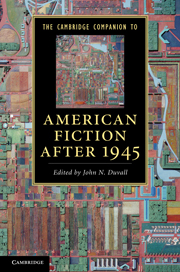Book contents
- Frontmatter
- Introduction: A story of the stories of American fiction after 1945
- PART I POETICS AND GENRES
- 1 Postmodern metafiction
- 2 Contemporary realism
- 3 New journalism and the nonfiction novel
- 4 Science fiction
- 5 The short story
- PART II HISTORICAL AND CULTURAL CONTEXTS
- PART III MAJOR AUTHORS
- Conclusion: Whither American fiction?
- Index
- Cambridge Companions to …
4 - Science fiction
from PART I - POETICS AND GENRES
Published online by Cambridge University Press: 28 March 2012
- Frontmatter
- Introduction: A story of the stories of American fiction after 1945
- PART I POETICS AND GENRES
- 1 Postmodern metafiction
- 2 Contemporary realism
- 3 New journalism and the nonfiction novel
- 4 Science fiction
- 5 The short story
- PART II HISTORICAL AND CULTURAL CONTEXTS
- PART III MAJOR AUTHORS
- Conclusion: Whither American fiction?
- Index
- Cambridge Companions to …
Summary
Science fiction represents, along with film, one of the most significant global forms to emerge in the twentieth century, its estranging visions of other worlds bringing into focus the dramatic transformations that define modernity. Thus, as Pascale Casanova argues in the case of the novel more generally, it is difficult to constrain its history to one nation. However, by the end of World War II, the United States had come to dominate science fiction. The story of how this came to pass is a fascinating one. While there were major American precursors – including Edgar Allan Poe and Edward Bellamy – what we think of as science fiction emerged at the close of the nineteenth century in the “scientific romances” of the British author, H. G. Wells. Wells's work paved the way for a dramatic global production of the genre in a diverse group of writers, many of whom treat science fiction as a form of modernist experimental literature.
However, a number of developments in the 1920s helped conclude this opening chapter in the genre's history. First, the increasing intolerance within the Soviet Union for artistic experimentation put one fecund tradition on hold until the 1950s. Second, as Roger Luckhurst maintains, the use of Wells's work as “a negative foil in aesthetics” by the British modernist writing establishment meant that those “who continued with the scientific romance did so in conditions of marginality and insularity. Finally and most significantly, the emergence of science fiction pulp magazines, beginning in 1926 with Amazing Stories under the editorship of Hugo Gernsback (who also coined the term “science fiction”), set the genre’s agenda for the coming decades.
- Type
- Chapter
- Information
- The Cambridge Companion to American Fiction after 1945 , pp. 56 - 67Publisher: Cambridge University PressPrint publication year: 2011

